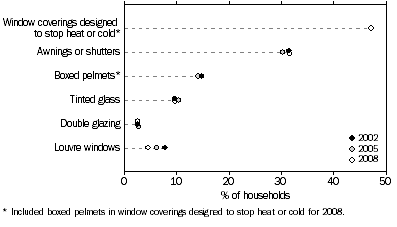WINDOW TREATMENT/APPLICATION
Window protection and shading reduces the amount of heat lost or gained by a dwelling. As windows can be a source of up to 40-60% of heat loss from a house, window treatments can produce energy efficiencies for households (SEDO 2008). The amount of heat lost or gained through windows is relative to the location, size and to the nature and extent of applied window treatments.
More than one-third of Australian dwellings (35% in 2008) did not have any type of window treatments to reduce heat loss or gain. New South Wales had the highest proportion of dwellings (45%) with no window treatments. Table 2.24 indicates that window coverings designed to stop heat or cold were the principal form of window protection applied in 47% of dwellings in Australia (graph 2.5). This measure was most common in South Australia (62% of dwellings), the Australian Capital Territory (60% of dwellings) and Victoria (59% of dwellings). Outside awnings or shutters were the next most common form of window treatment with 32% of Australian dwellings reporting their use. Outside awnings or shutters were most common in South Australia (44% of dwellings) and Victoria (41% of dwellings). Double glazing was most frequently used in the cooler states and territories of Tasmania (6% of dwellings) and the Australian Capital Territory (5% of dwellings).
2.5 Window treatments in dwellings
